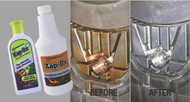How to Get Stains Out in Plastic Injection Molding
Posted by by Nanomold Coating on 2022 Mar 28th
When you encounter rust, oxidation, buildup, discoloration, and other stains in plastic injection molding, you know both your production and your output is going to be adversely affected. You need to halt production so you can properly clean the mold, which further decreases efficiency and output, which has already been impacted by more scrap or rejects.
Causes of Mold Buildup, Discoloration, Rust, and Oxidation
Mold rust, oxidation, and gas stains can be a result of a number of things, but the most frequent culprit is exposure to water or corrosive gases. Improper shutdown of a mold and incorrect drying of the material can also lead to mold oxidation and rust. If it’s a process-based issue, you might be dealing with a too-high melt temperature, too-long residence time, excessive shear rates, poor venting or low-flow areas in the injection barrel or hot-runner system.
Mold buildup usually comes from volatiles leaving the plastic and collecting on the mold surface. When this happens, the part will often have a rough surface. Buildup can also lead to flash and other part defects, all of which can increase scrap and decrease efficiency.
Discoloration is a problem because it creates inconsistency among the parts, potentially creating scrap. Discoloration in the barrel or the mold can transfer to the parts, leading to the problem. Most often, discoloration is caused by poor venting or a too-small mold gate, nozzle, spruce or runner size. Using too much grease or mold release can also lead to discoloration.
Non-Caustic Zap-Ox Removes Rust, Oxidation, Buildup, Discoloration, and More
If you need to shut down to work on any of these issues, the best option for cleaning is Zap-Ox (or the no-grit version, Zap-Ox NG). It’s non-caustic, so it is operator-friendly and will not corrode the metal, and a thin coat Zap-Ox pulls the stain or discoloration to the surface without scrubbing, removing it in just a few minutes.

